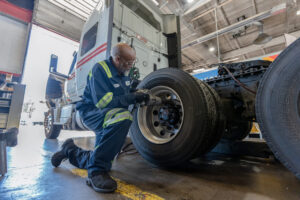Every fleet has unique goals and needs, but there are ten features that contribute to a successful fleet maintenance program.
1. Safety First
A fleet maintenance program has to prioritize safety. Safe programs incorporate the use of personal protective equipment (PPE), technician and manager training, as well as management teams to monitor safety protocols. Priority and consistency are key.
2. Top-Tier Technicians
All effective fleet maintenance programs work with top-tier technicians. Automotive technology continuously evolves. A generational shift is pushing younger men and women away from traditional skilled trade professionals. And there is a growing need for specialized certifications.
Because of these challenges, embracing online tools and utilizing a focused hiring team can help recruit top talent. Not only to hire new technicians but to keep monitoring employee job satisfaction in order to retain the best and brightest technicians.
3. Proactive Preventative Maintenance (PM)
Every fleet maintenance program should focus on PM. Proactive PM is key to minimizing downtime and controlling maintenance costs.
The goal of proactive PM is to prevent the vehicle from needing repairs until the next PM is due. Operationally, this means preventing road failures, garage drive-ups and any type of out-of-service repair activity between scheduled maintenance dates.
Keeping a close eye on PM success and failure rates can yield immediate results. And improve the quality of your PM by keeping vehicles on the road and maintenance costs down.
4. Monitoring Quality
Monitoring the quality of your vehicle maintenance programs begins by defining your key performance indicators (KPIs). Many fleets monitor quality through measurements like task repeats and standard repair times.
In addition to monitoring KPIs, it’s important to have operational standards with proper tools and processes in place.
5. Teamwork
Efficient fleet maintenance programs are supported by a number of different individuals from within an organization.
Larger teams from procurement, drivers, HR, and even IT need to work together as a cohesive unit in order for a program to be successful.
6. Commitment to Data
Fleets today are more data-driven than ever. It’s crucial that your program has the means and discipline to capture and analyze the best data possible.
Fleet managers are also inundated with data sources like never before. Each data stream is a piece of the total pie, and to quickly and efficiently analyze the data and spot trends, your data streams should be integrated within your fleet management system (FMS).
This integrated data can then be used to make decisions at every level of vehicle maintenance programs including PM, asset management, total cost of ownership (TOC) and quality of repairs.
7. Experienced Management
Along with hiring top-tier technicians, employing respected fleet managers is imperative to a fleet maintenance program. Having a comprehensive background in maintenance is critical, as it relates not only to the leadership of employees but also the depth of knowledge and expertise to problem solve.
Fleet Managers (FMs) should be skilled leaders, mentors and managers. They should be able to offer advice and training to their technicians. FMs should also be expected to inspect a technician’s work to guarantee accurate, safe, high-quality work. And if problems are found, your FMs should be able to coach the employee and improve that person’s performance, skills and quality.
8. Limiting Outside Spend
A strong PM program can limit outside spending by improving fleet performance and eliminating costly breakdowns. Planning an effective PM program for your fleet maintenance program involves much more than a simple lube or oil filter. PM protocols should cover the vehicle from bumper-to-bumper, catching problems early on so the vehicle can avoid costly repairs down the road.
The right staffing can also limit outside spend. Ensure teams have the right number of individuals, but also the appropriate skill sets to keep all maintenance and repairs in-house.
These proactive approaches can improve vehicle uptime at a lower cost.
9. Secure Best Parts (and Pricing)
It is essential for every fleet maintenance program to make informed decisions when choosing between aftermarket and original equipment (OE) parts. When selecting aftermarket, fleets should consider whether or not the part offers a reduction in cost without sacrificing quality.
10. Recover Warranty Cash
An important facet of managing expenses for a fleet maintenance program is warranty collection. A warranty left uncollected, can leave money on the table that should be used to offset the costs of a maintenance operation.
Having a system in place, like entering warranty information into an FMS immediately when a vehicle is cycled into the fleet, can help notify maintenance about repair warranties. And help you implement the three c’s of warranty reclamation: condition (or complaint), cause and correction.
Conclusion
At Amerit, we have built our reputation on being the country’s most dependable, trustworthy and hard-working partner through our singular focus on doing one thing and doing it better than anyone else – Fleet Maintenance and Repair Services.
To speak with a member of our team today, please request a quote.



